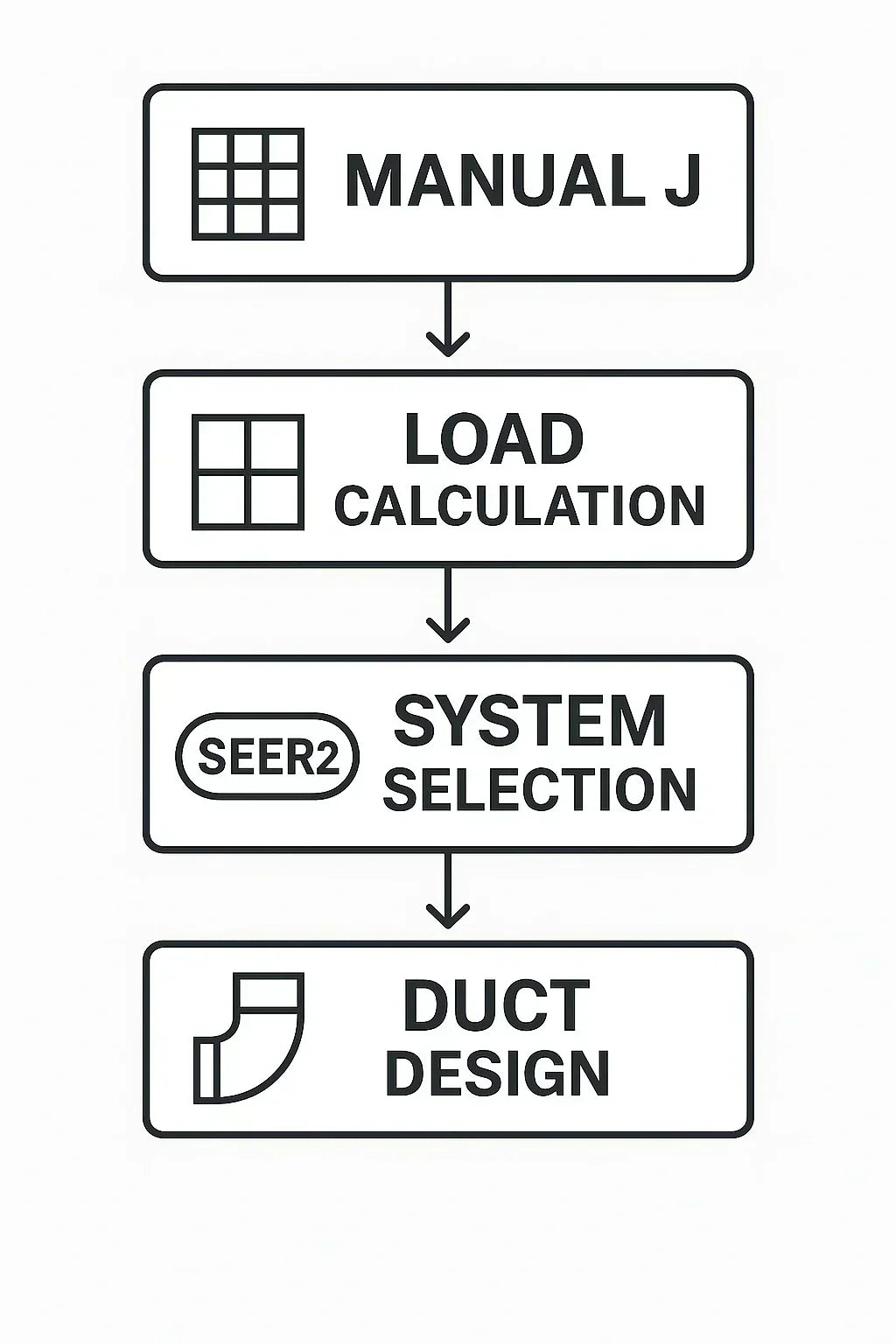When homeowners think about HVAC efficiency, they often focus on the SEER2 rating — and for good reason. Higher SEER2 ratings mean lower energy bills and better performance. But here’s what most people don’t realize: SEER2 also impacts how your HVAC system should be sized.
And if your contractor is still using the “rule of thumb” method — sizing based on square footage alone — you could end up with a system that’s oversized, inefficient, and uncomfortable.
In this guide, I’ll explain how SEER2 affects load calculations, airflow requirements, ductwork design, and why precision matters more than ever when choosing the right HVAC size for your home.
SEER2 Isn’t Just a Label — It Affects System Design
What SEER2 Actually Measures
SEER2 stands for Seasonal Energy Efficiency Ratio 2, and it replaced the older SEER standard in 2023. Unlike SEER, which tested equipment in lab-like conditions, SEER2 factors in real-world static pressure — including duct resistance. This makes it a more realistic measure of how efficiently your system will cool your home.
📘 SEER2.com – About the New SEER2 Standard
The Basics of HVAC Sizing: Manual J Load Calculations
Before you can choose a system size, you need to know how much heating or cooling your home actually requires. This is done through a Manual J calculation — the industry-standard method for calculating BTUs per hour.
Factors That Affect Load:
-
Home square footage
-
Window size and orientation
-
Insulation levels
-
Air infiltration
-
Local climate zone
📘 ACCA – Manual J Residential Load Calculation Guide
These calculations are then matched to HVAC equipment in tons, where 1 ton = 12,000 BTUs/hr. But here’s the catch: high-SEER2 systems perform differently under load, and that affects sizing choices.
Higher SEER2 Doesn’t Mean Smaller Systems — It Means Smarter Sizing
Efficiency Isn’t the Only Factor
A 3-ton, 14.3 SEER2 air conditioner and a 3-ton, 18 SEER2 unit both move the same amount of air — but the higher-SEER2 system does it more efficiently. That doesn’t mean you can downsize the equipment. Instead, you need to:
-
Match capacity to the Manual J load
-
Consider how staging and variable-speed features align with real-world demand
-
Account for system performance at part-load, not just peak
📘 NREL – Building America HVAC Sizing Guide
The Role of Airflow and Static Pressure
Because SEER2-rated systems are tested under real-world pressure conditions, your ductwork and airflow matter more than ever.
Undersized or leaky ducts can:
-
Restrict airflow
-
Increase static pressure
-
Reduce actual SEER2 performance
-
Cause short cycling or poor dehumidification
That’s why a proper sizing job also requires a Manual D duct design calculation — to ensure the system operates within manufacturer specs and delivers the rated efficiency.
📘 DOE Guide to Home Heating & Cooling
Why Oversizing a SEER2 System Is Still a Big Mistake
A common myth is that “more BTUs = better comfort,” but that’s rarely true. In fact, oversizing is one of the most common causes of HVAC underperformance.
Here’s what can go wrong:
❌ Short Cycling
The system runs for very short bursts, failing to remove humidity or evenly distribute air.
❌ Reduced Efficiency
SEER2 ratings assume the system operates at part load for most of the time. Oversized systems run in short spurts at full load — which means you’re not getting the advertised efficiency.
❌ Faster Wear and Tear
Frequent starts and stops wear down motors, compressors, and blowers faster.
📘 American Standard – HVAC Sizing Glossary
What Homeowners Should Ask Their Contractor
To avoid sizing mistakes — especially when investing in a high-SEER2 system — ask these key questions:
✅ “Are you doing a Manual J calculation for my home?”
If the answer is “no,” or “we base it on square footage,” that’s a red flag.
✅ “How will you ensure the ducts match the system?”
Efficient airflow is just as important as system efficiency.
✅ “Will this system run efficiently at my load?”
High-SEER2 systems perform best when properly matched to actual demand — not just peak demand.
Final Thoughts: Efficiency and Sizing Go Hand in Hand
Upgrading to a high-SEER2 system is a smart move — but only if your system is sized and installed correctly. The new testing standards have raised the bar, not just for equipment performance, but for how contractors need to approach sizing, ductwork, and airflow.
If you want to get the most out of your investment, make sure your contractor uses proper load calculations, understands SEER2 design requirements, and tailors the system to your home’s actual needs. For a full breakdown of how SEER2 works and why it replaced the original SEER rating, check out our guide: What is SEER2 and Why It Matters.
👉 Next in the Series: The Role of External Static Pressure in SEER2 Testing Standards
Alex Lane
Your Home Comfort Advocate







